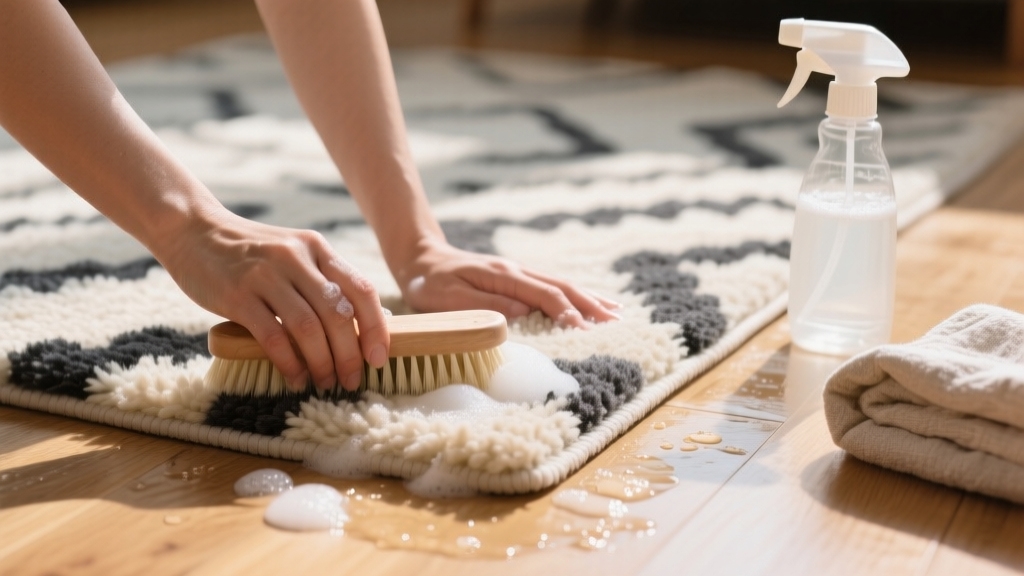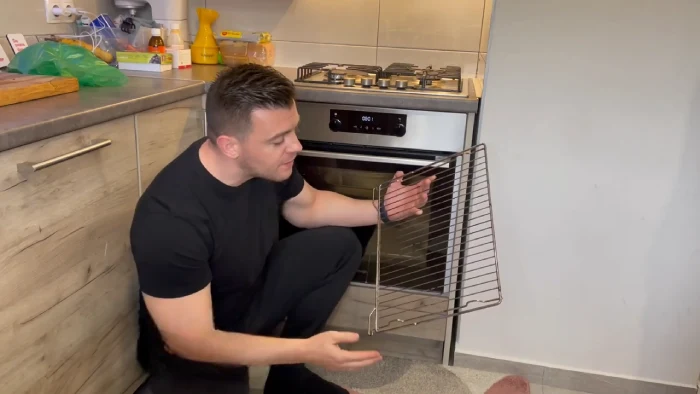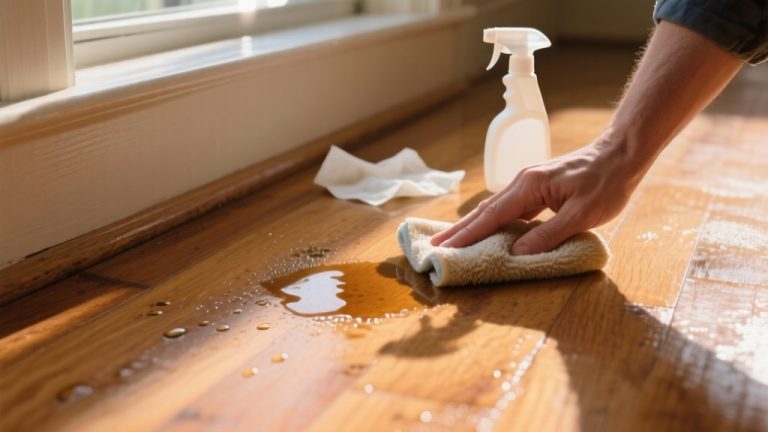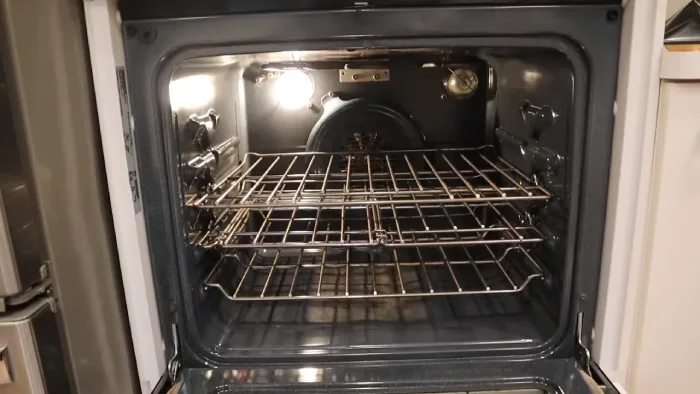Best Way to Clean a Wool Rug: Expert Tips for Safe Care
To clean your wool rug effectively, vacuum it weekly with gentle suction. Avoid rubbing spills; instead, blot immediately using a white cloth and a WoolSafe-approved spot remover.
For deeper cleaning, dry powders lift dirt without moisture damage. Wet cleaning requires mild, pH-neutral detergents and quick drying to prevent mold.
Avoid harsh scrubbing and test cleaners on hidden areas first. For stubborn stains or thorough care, professional cleaning is best.
Keep going to uncover detailed cleaning techniques and expert tips.
Key Takeaways
- Vacuum weekly with adjustable suction and soft-bristle attachments, avoiding fringes and rotating the rug every 3-6 months for even wear.
- Blot spills immediately with a white cloth; use cold water and WoolSafe-approved spot removers for stain treatment without over-saturating.
- Employ dry cleaning powders or shampoos to lift dirt quickly, preserving fibers and colors while preventing moisture-related damage.
- For deeper cleaning, use mild, pH-neutral detergent with cold water, rinsing well and drying promptly; avoid steam extraction unless professionally managed.
- Always test spot cleaners on hidden areas first and consult professionals for persistent stains or extensive cleaning to maintain rug longevity.
Routine Maintenance for Wool Rugs
Although wool rugs are durable, maintaining their appearance and longevity requires consistent, careful attention. You should vacuum them at least once a week using adjustable suction set to medium or high to remove dirt without damaging the fibers. Avoid vacuuming fringes to prevent fraying.
Use slow, overlapping passes with soft-bristle attachments to lift dirt gently. Regularly groom your rug with a soft-bristled carpet rake, working in the pile’s direction to restore texture without damaging fibers. For high-pile rugs, fluff fibers with your fingers or a wide-tooth comb.
Rotate your rug every 3 to 6 months to ensure even wear and prevent fading. Keep it away from direct sunlight and use furniture pads to avoid crushing the pile. Additionally, vacuuming often ignored areas like edges and under furniture helps remove hidden dust and sediment that can degrade the rug over time.
Always ensure proper ventilation in the cleaning area to avoid moisture buildup that can damage wool fibers. These methodical steps preserve your wool rug’s integrity and extend its lifespan.
Effective Spot Cleaning Techniques
When a spill occurs on your wool rug, you need to act quickly to prevent stains from setting permanently. Start by scooping solids gently with a spoon and blot liquids immediately using a clean white cloth. Never rub, as this spreads the stain and damages fibers. Using gentle, pH-balanced cleaners can help protect the delicate wool fibers during spot treatment.
For sticky substances, freeze with ice in a plastic bag before scraping.
Prepare a mild solution of one teaspoon gentle dish detergent in lukewarm water or use a WoolSafe approved spot remover. Apply sparingly with a cloth or spray bottle, avoiding saturation. Use approximately 10 ml per spot of solution to prevent over-wetting and potential damage. Avoid harsh chemicals such as bleach or ammonia to maintain the rug’s integrity.
After treatment, blot with clean water to rinse residues, then dry promptly with a cloth. Restore the pile gently and consider using sticky tape to remove loosened debris.
Always test cleaners on hidden areas first and consult professionals for persistent stains. Persistent or deep-set stains may require professional cleaning to avoid damage.
Using Dry Cleaning Methods on Wool Rugs
If you have a wool rug that’s a bit sensitive to moisture, you’re really going to appreciate dry cleaning methods. They’re super handy because they gently lift dirt and allergens without soaking the fibers.
These methods are especially beneficial because they help preserve wool rug’s natural beauty and softness, ensuring your rug looks and feels great for years. Have you ever tried using dry powder or dry shampoo?
It’s a game changer! With these, you can tackle surface stains effectively while keeping your rug’s texture and color just as they should be. Using multi-functional cleaning tools designed for gentle care can enhance the effectiveness of these dry methods.
And the best part? When you use these techniques the right way, your rug dries quickly and keeps its integrity over time. It’s a win-win!
Benefits of Dry Cleaning
Because dry cleaning uses no water, it offers significant advantages for maintaining wool rugs, particularly in preserving their appearance and structural integrity.
Without moisture, you eliminate risks of mildew, mold, and fiber shrinkage. This method protects colors and intricate patterns from bleeding or fading, ensuring your rug retains its original vibrancy and texture. Additionally, dry cleaning methods provide effective cleaning without leaving residue that can dull fibers.
Dry cleaning is gentle on wool fibers, preventing matting, shedding, and distortion common with wet cleaning. It also speeds up turnaround time, allowing use within one to two hours, which minimizes disruption in busy environments. Wool carpets are naturally fire-resistant, adding an extra layer of safety to your home.
Additionally, dry cleaning effectively removes allergens and dirt without promoting bacterial growth, making it ideal for sensitive households.
You can perform this process regularly without damaging fibers, supporting long-term rug health and appearance.
Dry Powder Application
Dry powder application offers a practical approach to maintaining wool rugs through low-moisture cleaning techniques.
You sprinkle a commercial powder evenly across the rug, then work it gently into the fibers with a soft brush. This method helps prevent excess moisture that could lead to mold growth in delicate fibers.
After allowing it to sit, you vacuum up the powder, which lifts surface dirt and odors.
This method suits light maintenance but isn’t effective for heavy stains or deeply embedded dirt.
Use powders specifically formulated for wool and avoid over-application to prevent residue or fuzziness.
While dry cleaning powders are least effective for heavy soils, they are among the safest options for delicate fibers like wool.
| Comfort | Cleanliness | Carefulness |
|---|---|---|
| Soft brush use | Dirt removal | Avoid overuse |
| Low moisture | Odor absorption | Label checking |
| Gentle handling | Surface cleaning | Ventilated area |
This method balances effectiveness with fiber safety.
Wet Cleaning and Steam Extraction Tips
When cleaning a wool rug with water, it’s crucial to control moisture carefully to protect the fibers and backing. Use cold or lukewarm water with a mild, pH-neutral detergent, and avoid over-saturating the rug. Regular maintenance similar to moisture control practices helps prevent damage and prolongs the rug’s life.
Begin by vacuuming to remove loose debris. Vacuum the rug 3-5 times on both sides before wet cleaning to remove embedded dirt. For spot cleaning, apply a damp cloth with wool-safe detergent, then rinse with clean water to eliminate residues.
Steam extraction generally isn’t recommended due to excessive moisture. If used, apply minimal water and ensure rapid drying.
Always dry your rug within 24 hours in a well-ventilated area, using fans or dehumidifiers, and avoid direct sunlight. Check for residual moisture in the pile and backing before use.
Test any cleaning solution on a hidden spot first to prevent color bleeding or fiber damage.
When to Seek Professional Wool Rug Cleaning?
Controlling moisture and using gentle cleaning methods at home can maintain your wool rug’s condition between professional services. Because wool fibers are sensitive, improper cleaning can cause shrinkage or damage if not handled properly. It is important to avoid mixing cleaning agents like bleach and OxiClean, as this can produce toxic gases and damage the rug fibers.
However, you should seek professional cleaning when routine care isn’t enough. Professionals recommend deep cleaning every 12 to 18 months, or more often in high-traffic areas.
Look for these signs indicating it’s time:
- Persistent odors remain despite home cleaning.
- Rug feels stiff or gritty underfoot.
- Visible soil or discoloration won’t lift with vacuuming.
- Increased allergies or respiratory issues suggest allergen buildup.
Choosing a WoolSafe Certified Service Provider ensures safe, pH-neutral cleaning methods that protect your rug’s fibers and warranty.
Avoid DIY risks like shrinking or color bleeding by trusting experts to restore your rug’s softness, vibrancy, and longevity.
Handling Stains and Special Treatments Safely
When a stain happens, it’s super important to act fast. Grab a clean, white cloth and start blotting right away. This can really help stop the stain from setting or spreading. For instance, you can use warm water to gently dab the stain, working from the outside toward the center to avoid spreading it. Using enzymatic shampoos can be especially effective for breaking down organic stains safely on wool fibers.
Now, if you’re dealing with something sticky, don’t go scrubbing at it. Instead, try to gently soften the residue with a mild solution. Once it’s a bit loosened up, you can carefully lift it away.
And here’s a tip: always use spot removers that are approved for wool. This is key to protecting those delicate fibers and keeping your rug in great shape!
Immediate Blotting Techniques
Although stains on wool rugs can seem intimidating, acting immediately with proper blotting techniques can prevent permanent damage and preserve the rug’s delicate fibers.
Here’s how to handle spills effectively:
- Blot spills promptly using a clean white cloth or paper towel; avoid rubbing to prevent embedding stains deeper.
- Use cold water initially to dilute protein or tannin stains like coffee, applying with a dab-and-lift motion. This method helps preserve the wool’s natural fibers and prevents fiber damage.
- For special stains, apply diluted vinegar gently, limiting moisture and contact time to protect wool fibers.
- Always work from the stain’s outer edge inward to restrict spreading and avoid saturating the rug to prevent mold growth. Wool carpets require gentler cleaning agents than harsh chemicals to maintain fiber integrity.
Following these methodical steps protects your rug while ensuring effective stain removal without fiber damage.
Removing Sticky Substances
How do you safely remove sticky substances from a wool rug without causing damage?
Start by hardening the residue with ice. Place ice cubes in a plastic bag and apply them to the spot.
Once hardened, gently scrape off the substance using a dull knife or spoon to avoid fiber damage. It is important to avoid vinegar on wool rugs as it can discolor or weaken the fibers.
Next, dampen a clean cloth with lukewarm water mixed with a wool-safe mild detergent. Using plant-based enzymes in the detergent can help break down organic residues gently without harming the wool.
Press the cloth on the stain for 5 to 10 minutes to loosen the residue without rubbing aggressively.
Rinse thoroughly to prevent detergent buildup.
Avoid acidic solutions like vinegar, as they can discolor or weaken wool fibers.
For stubborn or large sticky stains, consult a professional cleaner who uses specialized treatments designed to protect your rug’s natural fibers and ensure safe, effective removal.
Using Approved Spot Removers
After carefully removing sticky substances, you’ll want to handle other types of stains with products specifically designed for wool.
Always choose WoolSafe approved spot removers to prevent fiber damage and color loss. Here’s how to proceed safely:
- Test the product on a hidden area to confirm no adverse effects.
- Use mild, pH-neutral removers formulated for protein fibers; avoid enzyme or peroxide-based agents. These powders are often safe for delicate fibers like wool and silk.
- Apply the spot remover according to manufacturer instructions, controlling dwell time and avoiding excess moisture.
- Blot gently with a white, lint-free cloth to lift stains without spreading or damaging fibers.
Following these steps protects your wool rug’s integrity and appearance, preventing irreversible damage or warranty voids.
For stubborn stains, consider professional cleaning to maintain ideal rug condition.
Frequently Asked Questions
How Do I Prevent Moth Damage to My Wool Rug?
You prevent moth damage by vacuuming your wool rug and nearby areas regularly, especially under furniture.
Store the rug in airtight containers with moisture absorbers to keep humidity low.
Rotate and air out your rug outdoors periodically to disrupt moth life cycles.
Use natural repellents like cedar or lavender and inspect frequently for moth signs, acting quickly if detected.
Avoid dark, damp storage spots and maintain good air circulation around your rug.
Can I Use a Vacuum Without a Beater Bar on Wool Rugs?
You’re wise to contemplate gentler methods. Yes, you can absolutely use a vacuum without a beater bar on wool rugs. This approach safeguards delicate fibers from unnecessary wear.
Opt for suction-only vacuums or those allowing brush roll deactivation. Move slowly with overlapping passes, adjusting suction to avoid pulling fibers.
Avoid aggressive strokes or vacuuming wrinkled areas. Regular, careful vacuuming keeps your wool rug pristine while preserving its natural beauty and longevity.
What Is the Best Way to Store a Wool Rug Long-Term?
For long-term storage, roll your wool rug with the pile side up around a sturdy cardboard tube to avoid creases and strain.
Wrap it in breathable materials like cotton or acid-free paper; never plastic.
Store the rolled rug in a cool, dry, dark place with stable temperature and humidity, ideally between 50-70°F and 40-60% humidity.
Keep it off the floor, away from pests by adding cedar blocks, and check regularly for mold or damage.
Are Wool Rugs Safe for Homes With Pets and Children?
You’ll be amazed how safe wool rugs are for homes with pets and children. They’re practically superheroes in disguise!
Wool’s natural fibers resist stains, repel dust mites, and stay hypoallergenic, protecting your family from allergens and irritants.
Plus, wool is chemical-free and fire-retardant, making it a healthy, non-toxic choice.
Just vacuum regularly and clean spills promptly to keep your wool rug safe and cozy for your loved ones.
How Do Humidity and Temperature Affect Wool Rug Care?
Humidity and temperature directly impact your wool rug’s health. High humidity swells fibers, causing mold and musty odors, while low humidity dries fibers, making them brittle and prone to breakage.
Temperature fluctuations worsen this by shrinking or stretching fibers.
You should maintain indoor humidity between 30–50%, using humidifiers in winter and dehumidifiers in summer.
Regular monitoring and proper airflow prevent moisture buildup, preserving your rug’s texture and longevity effectively.
Take the Next Step Toward Smarter Wool Rug Maintenance
Caring for your wool rug is like nurturing a delicate flower. It needs regular attention and the right techniques to thrive.
By sticking to routine maintenance, tackling spots promptly, and knowing when to call in professionals, you’ll keep your rug looking its best for years. Always handle stains with care and choose cleaning methods suited to wool’s unique fibers.
With patience and precision, your wool rug will remain a beautiful, lasting centerpiece in your home.







